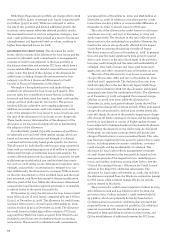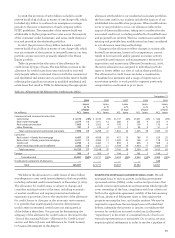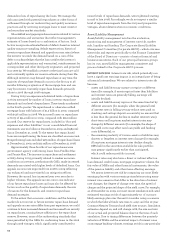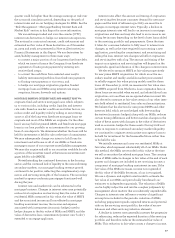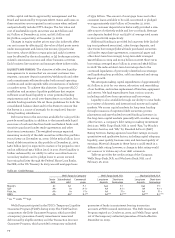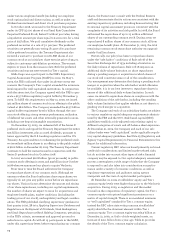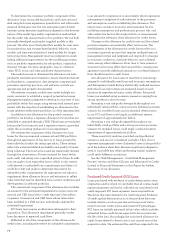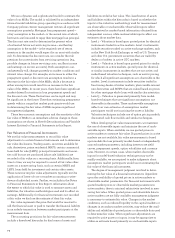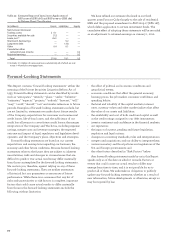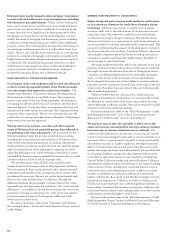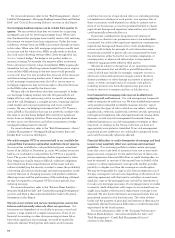Wells Fargo 2009 Annual Report Download - page 76
Download and view the complete annual report
Please find page 76 of the 2009 Wells Fargo annual report below. You can navigate through the pages in the report by either clicking on the pages listed below, or by using the keyword search tool below to find specific information within the annual report.
To determine the consumer portfolio component of the
allowance, loans are pooled by portfolio and losses are mod-
eled using historical experience, quantitative and other math-
ematical techniques over the loss emergence period. Each
business group exercises significant judgment in the determi-
nation of the model type and/or segmentation method that
fits the credit risk characteristics of its portfolio. We use both
internally developed and vendor supplied models in this
process. We often use roll rate/net flow models for near-term
loss projections, and vintage-based models, behavior score
models, and time series/statistical trend models for longer-
term projections. Management must use judgment in estab-
lishing additional input metrics for the modeling processes,
such as portfolio segmentation by sub-product, origination
channel, vintage, loss type, geographic, loan to collateral
value, FICO score, and other predictive characteristics.
The models we use to determine the allowance are inde-
pendently validated and reviewed to ensure that their theoret-
ical foundation, assumptions, data integrity, computational
processes, reporting practices, and end-user controls are
appropriate and properly documented.
We estimate consumer credit losses under multiple eco-
nomic scenarios to establish a range of potential outcomes.
Management applies judgment to develop its own view of loss
probability within that range, using external and internal para-
meters with the objective of establishing an allowance for the
losses inherent within these portfolios as of the reporting date.
In addition to the allowance for the pooled consumer
portfolios, we develop a separate allowance for loans that are
identified as impaired through a TDR. These loans are excluded
from pooled loss forecasts and a separate reserve is provided
under the accounting guidance for loan impairment.
We estimate the component of the allowance for loan
losses for the non-impaired commercial and CRE portfolios
through the application of loss factors to loans grouped by
their individual credit risk rating specialists. These ratings
reflect the estimated default probability and quality of under-
lying collateral. The loss factors used are statistically derived
through the observation of losses incurred for loans within
each credit risk rating over a specified period of time. In addi-
tion, we apply a loan equivalent factor, which is also statisti-
cally derived, to unfunded loan commitments and letters of
credit by credit risk grade to determine the reserve for
unfunded credit commitments. As appropriate, we adjust or
supplement these allowance factors and estimates to reflect
other risks that may be identified from current conditions and
developments in selected portfolios.
The commercial component of the allowance also includes
an amount for the estimated impairment in nonaccrual com-
mercial and CRE loans with a credit exposure of $5 million
or greater. Commercial and CRE loans whose terms have
been modified in a TDR are also individually analyzed for
estimated impairment.
PCI loans may require an allowance subsequent to their
acquisition. This allowance requirement generally results
from decreases in expected cash flows.
Reflected in all of the components of the allowance for
credit losses, including the reserve for unfunded commitments,
is an amount for imprecision or uncertainty, which represents
management’s judgment of risks inherent in the processes
and assumptions used in establishing the allowance. This
imprecision considers economic environmental factors,
modeling assumptions and performance, process risk, and
other subjective factors. No single statistic or measurement
determines the adequacy of the allowance for credit losses.
Changes in the allowance for credit losses and the related
provision expense can materially affect net income. The
establishment of the allowance for credit losses relies on a
consistent quarterly process that requires multiple layers of
management review and judgment and responds to changes
in economic conditions, customer behavior, and collateral
value, among other influences. From time to time, events or
economic factors may affect the loan portfolio, causing man-
agement to provide additional amounts to or release balances
from the allowance for credit losses.
Our allowance for loan losses is sensitive to risk ratings
assigned to individually rated loans and economic assumptions
and delinquency trends driving statistically modeled reserves.
Individual loan risk ratings are evaluated based on each
situation by experienced senior credit officers. Forecasted
losses are modeled using economic scenarios ranging from
strong recovery to slow recovery.
Assuming a one risk grade downgrade throughout our
individually rated portfolio, a slow recovery (adverse) economic
scenario for modeled losses and incremental deterioration
in our PCI cash flows could imply an additional reserve
requirement of approximately $10 billion.
Assuming a one risk grade upgrade throughout our
individually rated portfolio and a strong recovery economic
scenario for modeled losses could imply a reduced reserve
requirement of approximately $3.3 billion.
These sensitivity analyses provided are hypothetical
scenarios and are not considered probable. They do not
represent management’s view of inherent losses in the portfolio
as of the balance sheet date. Because significant judgment is
used, it is possible that others performing similar analyses
could reach different conclusions.
See the “Risk Management – Credit Risk Management
Process” section and Note 6 (Loans and Allowance for Credit
Losses) to Financial Statements in this Report for further
discussion of our allowance.
Purchased Credit-Impaired (PCI) Loans
Loans purchased with evidence of credit deterioration since
origination and for which it is probable that all contractually
required payments will not be collected are considered to be
credit impaired. PCI loans represent loans acquired from
Wachovia that were deemed to be credit impaired. Evidence
of credit quality deterioration as of the purchase date may
include statistics such as past due and nonaccrual status,
recent borrower credit scores and recent LTV percentages.
PCI loans are initially measured at fair value, which includes
estimated future credit losses expected to be incurred over
the life of the loan. Accordingly, the associated allowance for
credit losses related to these loans is not carried over at the
acquisition date. We estimated the cash flows expected to be


